- Table of Contents
-
- 05-Layer 3 - IP Services Configuration Guide
- 00-Preface
- 01-ARP configuration
- 02-IP addressing configuration
- 03-DHCP configuration
- 04-DNS configuration
- 05-IP forwarding basics configuration
- 06-Adjacency table configuration
- 07-IP performance optimization configuration
- 08-UDP Helper configuration
- 09-IPv6 basics configuration
- 10-DHCPv6 configuration
- 11-Tunneling configuration
- 12-GRE configuration
- 13-IRDP configuration
- Related Documents
-
| Title | Size | Download |
|---|---|---|
| 11-Tunneling configuration | 390.23 KB |
Contents
Tunneling configuration task list
Configuring a tunnel interface
Configuring an IPv6 over IPv4 manual tunnel
Configuring an automatic IPv4-compatible IPv6 tunnel
6to4 tunnel configuration example
6to4 relay configuration example
Displaying and maintaining tunneling configuration
Troubleshooting tunneling configuration
Overview
Tunneling is an encapsulation technology. One network protocol encapsulates packets of another network protocol and transfers them over a virtual point-to-point connection. The virtual connection is called a tunnel. Packets are encapsulated at the tunnel source end and de-encapsulated at the tunnel destination end. Tunneling refers to the whole process from data encapsulation to data transfer to data de-encapsulation.
Tunneling supports the following technologies:
· Transition techniques, such as IPv6 over IPv4 tunneling, to interconnect IPv4 and IPv6 networks.
· VPN, such as IPv4 over IPv4 tunneling, IPv4/IPv6 over IPv6 tunneling, GRE, and IPsec tunneling.
· Traffic engineering, such as MPLS TE to prevent network congestion.
Unless otherwise specified, the term "tunnel" in this document refers to IPv6 over IPv4, IPv4 over IPv4, IPv4 over IPv6, and IPv6 over IPv6 tunnels.
IPv6 over IPv4 tunneling
Implementation
IPv6 over IPv4 tunneling enables isolated IPv6 networks to communicate, as shown in Figure 1.
|
|
NOTE: The devices at the ends of an IPv6 over IPv4 tunnel must support the IPv4/IPv6 dual stack. |
Figure 1 IPv6 over IPv4 tunnel
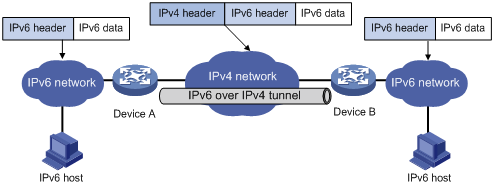
The IPv6 over IPv4 tunnel processes packets by using the following steps:
1. A host in the IPv6 network sends an IPv6 packet to Device A at the tunnel source.
2. After Device A receives the IPv6 packet, it processes the packet as follows:
a. Searches the routing table to identify the outgoing interface for the IPv6 packet.
The outgoing interface is the tunnel interface, so Device A knows that the packet needs to be forwarded through the tunnel.
b. Encapsulates the IPv6 packet with an IPv4 header and forwards it through the physical interface of the tunnel.
In the IPv4 header, the source IPv4 address is the IPv4 address of the tunnel source, and the destination IPv4 address is the IPv4 address of the tunnel destination.
3. Upon receiving the packet, Device B de-encapsulates the packet.
4. If the destination address of the IPv6 packet is itself, Device B forwards it to the upper-layer protocol. If not, Device B forwards it according to the routing table.
Tunnel modes
IPv6 over IPv4 tunnels include manually configured tunnels and automatic tunnels, depending on how the IPv4 address of the tunnel destination is acquired.
· Manually configured tunnel—The destination IPv4 address of the tunnel cannot be automatically acquired from the destination IPv6 address of an IPv6 packet at the tunnel source. It must be manually configured.
· Automatic tunnel—The destination IPv4 address of the tunnel can be automatically acquired from the destination IPv6 address (with an IPv4 address embedded) of an IPv6 packet at the tunnel source.
According to the way an IPv6 packet is encapsulated, IPv6 over IPv4 tunnels are divided into the following modes.
Table 1 IPv6 over IPv4 tunnel modes and key parameters
|
Tunnel type |
Tunnel mode |
Tunnel source/destination address |
Destination IPv6 address format |
|
Manually configured tunnel |
IPv6 over IPv4 manual tunneling |
The source and destination IPv4 addresses are manually configured. |
Ordinary IPv6 address |
|
Automatic tunnel |
Automatic IPv4-compatible IPv6 tunneling |
The source IPv4 address is manually configured. The destination IPv4 address is automatically obtained. |
IPv4-compatible IPv6 address, in the format of ::IPv4-destination-address/96, where the IPv4-destination-address is the IPv4 address of the tunnel destination. |
|
6to4 tunneling |
The source IPv4 address is manually configured. The destination IPv4 address is automatically obtained. |
6to4 address, in the format of 2002:IPv4-destination-address::/48, where the IPv4-destination-address is the IPv4 address of the tunnel destination. |
|
|
ISATAP tunneling |
The source IPv4 address is manually configured. The destination IPv4 address is automatically obtained. |
ISATAP address, in the format of Prefix:0:5EFE:IPv4-destination-address/64 where the IPv4-destination-address is the IPv4 address of the tunnel destination. |
· IPv6 over IPv4 manual tunneling—A point-to-point link and its source and destination IPv4 addresses are manually configured. This type of tunneling provides the following solutions:
¡ Connect isolated IPv6 networks over an IPv4 network.
¡ Connect an IPv6 network to an IPv4/IPv6 dual-stack host over an IPv4 network.
· Automatic IPv4-compatible IPv6 tunneling—A point-to-multipoint link. Both ends of the tunnel use IPv4-compatible IPv6 addresses. The address format is 0:0:0:0:0:0:a.b.c.d/96, where a.b.c.d is the IPv4 address of the tunnel destination. This mechanism simplifies tunnel establishment.
Automatic IPv4-compatible IPv6 tunnels have limitations because IPv4-compatible IPv6 addresses must use globally unique IPv4 addresses.
· 6to4 tunneling
¡ Ordinary 6to4 tunneling—A point-to-multipoint automatic tunnel. It is used to connect multiple isolated IPv6 networks over an IPv4 network. The destination IPv4 address of a 6to4 tunnel is embedded in the destination 6to4 address of packets. This mechanism enables the device to automatically obtain the tunnel destination address, simplifying tunnel establishment.
The 6to4 address format is 2002:abcd:efgh:subnet number::interface ID/48. 2002 is the fixed IPv6 address prefix, and abcd:efgh represents a 32-bit globally unique IPv4 address in hexadecimal notation. For example, 1.1.1.1 can be represented by 0101:0101. The IPv4 address identifies a 6to4 network (an IPv6 network where all hosts use 6to4 addresses). The border router of a 6to4 network must have the IPv4 address abcd:efgh configured on the interface connected to the IPv4 network. The subnet number identifies a subnet in the 6to4 network. The subnet number::interface ID uniquely identifies a host in the 6to4 network.
6to4 tunneling uses an IPv4 address to identify a 6to4 network. This method overcomes the limitations of automatic IPv4-compatible IPv6 tunneling.
¡ 6to4 relay—Connects a 6to4 network and an IPv6 network that uses an IP prefix other than 2002::/16. A 6to4 relay router is a gateway that forwards packets from a 6to4 network to an IPv6 network.
As shown in Figure 2, 6to4 network Site 1 communicates with IPv6 network Site 3 over a 6to4 tunnel. Configure a static route on the border router (Device A) in the 6to4 network. The next-hop address must be the 6to4 address of the 6to4 relay router (Device C). Device A forwards all packets destined for the IPv6 network over the 6to4 tunnel, and Device C then forwards them to the IPv6 network.
Figure 2 Principle of 6to4 tunneling and 6to4 relay
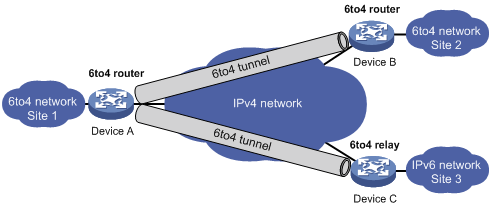
· ISATAP tunneling—An ISATAP tunnel is a point-to-multipoint automatic tunnel. It provides a solution to connect an IPv6 host to an IPv6 network over an IPv4 network.
The destination addresses of IPv6 packets are all ISATAP addresses. The ISATAP address format is prefix:0:5EFE:abcd:efgh. The 64-bit prefix is a valid IPv6 unicast address prefix. The abcd:efgh/64 segments represent a 32-bit IPv4 address, which identifies the tunnel destination but does not require global uniqueness.
ISATAP tunnels are mainly used for communication between IPv6 routers or between an IPv6 host and an IPv6 router over an IPv4 network.
Figure 3 Principle of ISATAP tunneling

IPv4 over IPv4 tunneling
IPv4 over IPv4 tunneling (RFC 1853) enables isolated IPv4 networks to communicate. For example, an IPv4 over IPv4 tunnel can connect isolated private IPv4 networks over a public IPv4 network.
Figure 4 IPv4 over IPv4 tunnel
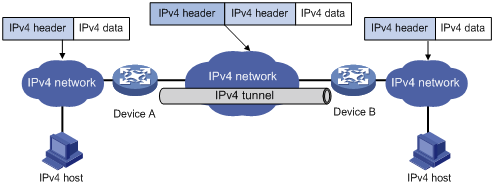
Packets traveling through a tunnel undergo encapsulation and de-encapsulation, as shown in Figure 4.
· Encapsulation:
a. Device A receives an IP packet from an IPv4 host and submits it to the IP protocol stack.
b. The IPv4 protocol stack determines how to forward the packet according to the destination address in the IP header. If the packet is destined for the IPv4 host connected to Device B, Device A delivers the packet to the tunnel interface.
c. The tunnel interface adds a new IPv4 header to the IPv4 packet and submits it to the IP protocol stack. In the new header, the source IP address specifies the tunnel source, and the destination IP address specifies the tunnel destination. The IP protocol stack uses the destination IP address of the new IP header to look up the routing table, and then sends the packet out.
· De-encapsulation:
a. After receiving the packet, Device B delivers it to the IP protocol stack.
b. If the protocol number is 4 (indicating an IPv4 packet is encapsulated within the packet), the IP protocol stack delivers the packet to the tunnel module for de-encapsulation.
c. The tunnel module de-encapsulates the IP packet and sends it back to the IP protocol stack.
d. The protocol stack forwards the de-encapsulated packet. \
|
|
NOTE: The device does not support IPv4 over IPv4 tunneling. |
IPv4 over IPv6 tunneling
Implementation
IPv4 over IPv6 tunneling adds an IPv6 header to IPv4 packets so that IPv4 packets can pass an IPv6 network through a tunnel to realize interworking between isolated IPv4 networks.
Figure 5 IPv4 over IPv6 tunnel
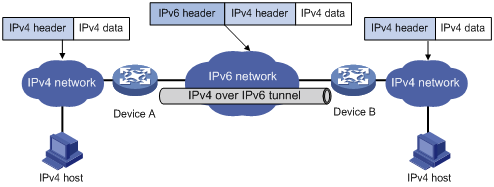
Packets traveling through a tunnel undergo encapsulation and de-encapsulation, as shown in Figure 5.
· Encapsulation:
a. Upon receiving an IPv4 packet, Device A delivers it to the IPv4 protocol stack.
b. The IPv4 protocol stack uses the destination address of the packet to determine the egress interface. If the egress interface is the tunnel interface, the IPv4 protocol stack delivers the packet to the tunnel interface.
c. The tunnel interface adds an IPv6 header to the original IPv4 packet and delivers the packet to the IPv6 protocol stack.
d. The IPv6 protocol stack uses the destination IPv6 address of the packet to look up the routing table, and then sends it out.
· De-encapsulation:
a. Upon receiving the IPv6 packet from the attached IPv6 network, Device B delivers the packet to the IPv6 protocol stack to examine the protocol type encapsulated in the data portion of the packet.
b. If the protocol type is IPv4, the IPv6 protocol stack delivers the packet to the tunneling module.
c. The tunneling module removes the IPv6 header and delivers the remaining IPv4 packet to the IPv4 protocol stack.
d. The IPv4 protocol stack forwards the IPv4 packet.
Tunnel modes
IPv4 over IPv6 tunnels include the following modes:
· IPv4 over IPv6 manual tunnel
A point-to-point link and its source and destination IPv6 addresses are manually configured. You can establish an IPv4 over IPv6 manual tunnel to connect isolated IPv4 networks over an IPv6 network.
· DS-Lite tunnel
Dual Stack Lite (DS-Lite) is a combination of the tunneling and NAT technologies. NAT translates the private IPv4 addresses of the IPv4 hosts before the hosts reach the IPv4 public network.
DS-Lite tunnel supports only an IPv4 host in a private network initiating communication with an IPv4 host on the Internet. It does not support an IPv4 host on the Internet initiating communication with an IPv4 host in a private network.
Figure 6 DS-Lite tunnel
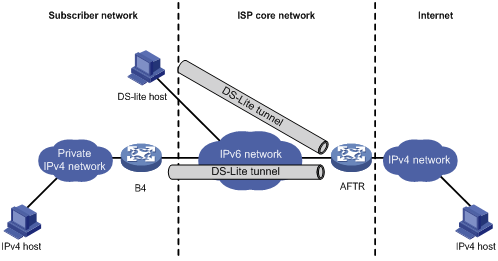
As shown in Figure 6, the DS-Lite feature contains the following components:
¡ Basic Bridging BroadBand (B4) element
The B4 element is typically a CPE router that connects end hosts. IPv4 packets entering the B4 router are encapsulated into IPv6 packets and sent to the AFTR. IPv6 packets from the AFTR are de-encapsulated into IPv4 packets and sent to the subscriber's network.
Hosts that can act as the B4 router are referred to as DS-Lite hosts.
¡ Address Family Transition Router (AFTR)
An AFTR resides in the ISP network and terminates the tunnel from the B4 router. NAT is also implemented on the interface that connects the public IPv4 network.
AFTR de-encapsulates the tunneled packet, translates the network address, and routes the packet to the destination IPv4 network. For IPv4 packets coming from the public IPv4 network, AFTR performs reverse address translation and sends them to the B4 router by using the DS-Lite tunnel.
Figure 7 Packet forwarding process in DS-Lite
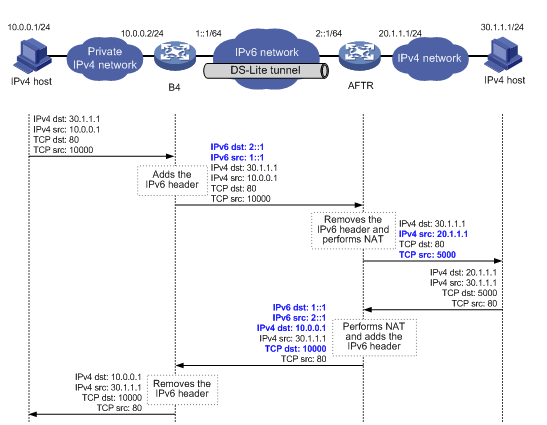
Figure 7 shows a packet passing through a DS-Lite tunnel between IPv4 networks.
a. Upon receiving a packet from the private IPv4 network, the B4 router adds an IPv6 header to the packet and sends the IPv6 packet to the AFTR through the tunnel.
b. The AFTR does the following:
- Removes the IPv6 header of the tunneled packet.
- Assigns a tunnel ID for the B4 router.
- Records the mapping between the IPv6 address of the B4 router (the source IPv6 address of the packet), and the tunnel ID.
c. After de-encapsulation, the AFTR translates the source private IPv4 address of the packet into a public IPv4 address and sends the packet to the destination IPv4 host. The AFTR also maps the NAT entries to the tunnel ID so that IPv4 networks connected to different B4 routers can use the same address space.
d. Upon receiving the response packet from the public network, the AFTR translates the destination public IPv4 address into the private IPv4 address. The AFTR does the following:
- Looks up the IPv6 address-tunnel ID mapping to obtain the IP address of the B4 router.
- Uses the address as the destination address of the encapsulated IPv6 packet.
- Forwards the packet to the B4 router.
Figure 7 shows an example of PAT translation for dynamic NAT. DS-Lite tunneling also supports static NAT and NO-PAT. Typically, dynamic NAT is used. When you use static NAT for DS-Lite tunneling, make sure the IP addresses of private IPv4 networks connecting to different B4 routers do not overlap.
|
|
NOTE: The device does not support IPv4 over IPv6 tunneling. |
IPv6 over IPv6 tunneling
IPv6 over IPv6 tunneling (RFC 2473) enables isolated IPv6 networks to communicate with each other over another IPv6 network. For example, two isolated IPv6 networks that do not want to show their addresses to the Internet can use an IPv6 over IPv6 tunnel to communicate with each other.
Figure 8 Principle of IPv6 over IPv6 tunneling
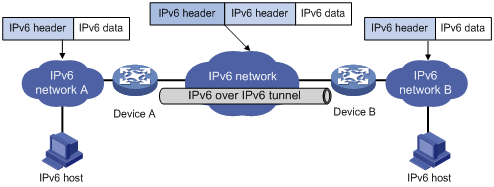
Figure 8 shows the encapsulation and de-encapsulation processes.
· Encapsulation:
a. After receiving an IPv6 packet, Device A submits it to the IPv6 protocol stack.
b. The IPv6 protocol stack uses the destination IPv6 address of the packet to find the egress interface. If the egress interface is the tunnel interface, the stack delivers it to the tunnel interface.
c. After receiving the packet, the tunnel interface adds an IPv6 header to it and submits it to the IPv6 protocol stack.
d. The IPv6 protocol stack forwards the packet according to its destination IPv6 address.
· De-encapsulation:
a. Upon receiving the IPv6 packet, Device B delivers it to the IPv6 protocol stack.
b. The IPv6 protocol stack checks the protocol type of the data portion encapsulated in the IPv6 packet. If the encapsulation protocol is IPv6, the stack delivers the packet to the tunnel module.
c. The tunnel module de-encapsulates the packet and sends it back to the IPv6 protocol stack.
d. The IPv6 protocol stack forwards the IPv6 packet.
|
|
NOTE: The device does not support IPv6 over IPv6 tunneling. |
Protocols and standards
· RFC 1853, IP in IP Tunneling
· RFC 2473, Generic Packet Tunneling in IPv6 Specification
· RFC 2893, Transition Mechanisms for IPv6 Hosts and Routers
· RFC 3056, Connection of IPv6 Domains via IPv4 Clouds
· RFC 4214, Intra-Site Automatic Tunnel Addressing Protocol (ISATAP)
· RFC 6333, Dual-Stack Lite Broadband Deployments Following IPv4 Exhaustion
Tunneling configuration task list
|
Tasks at a glance |
Remarks |
|
(Required.) Configuring a tunnel interface |
N/A |
|
(Required.) Configure an IPv6 over IPv4 tunnel: ¡ Configuring an IPv6 over IPv4 manual tunnel |
Perform one of the tasks. |
Configuring a tunnel interface
Configure a Layer 3 virtual tunnel interface on each device on a tunnel so that devices at both ends can send, identify, and process packets from the tunnel.
When an active/standby switchover occurs or the standby card is removed, the tunnel interfaces configured on the active or standby card still exist. To delete a tunnel interface, use the undo interface tunnel command.
To configure a tunnel interface:
|
Step |
Command |
Remarks |
|
1. Enter system view. |
system-view |
N/A |
|
2. Create a tunnel interface, specify the tunnel mode, and enter tunnel interface view. |
interface tunnel number mode { evi | gre | ipv6-ipv4 [ 6to4 | auto-tunnel | isatap ] } |
By default, no tunnel interface is created. When you create a new tunnel interface, you must specify the tunnel mode. When you enter the view of an existing tunnel interface, you do not need to specify the tunnel mode. The two ends of a tunnel must use the same tunnel mode. Otherwise, packet tunneling will fail. |
|
3. (Optional.) Configure a description for the interface. |
description text |
By default, the description for a tunnel interface is Tunnel number Interface. |
|
4. (Optional.) Specify a service card for forwarding the traffic on the tunnel interface (in standalone mode). |
service slot slot-number |
By default, no service card is specified. |
|
5. (Optional.) Specify a service card for forwarding the traffic on the tunnel interface (in IRF mode). |
service chassis chassis-number slot slot-number |
By default, no IRF member device or service card is specified. |
|
6. Set the MTU of the tunnel interface. |
mtu mtu-size |
By default, the MTU is 1500 bytes. |
|
7. Set the expected bandwidth for the tunnel interface. |
bandwidth bandwidth-value |
By default, the expected bandwidth is 64 kbps. The expected bandwidth for the tunnel interface affects the link cost value. For more information, see Layer 3—IP Routing Configuration Guide. |
|
8. Specify the VPN instance to which the tunnel destination belongs. |
tunnel vpn-instance vpn-instance-name |
By default, the tunnel destination belongs to the public network. The tunnel source and destination must belong to the same VPN. Otherwise, the tunnel interface cannot come up. To specify a VPN instance for the tunnel source, use the ip binding vpn-instance command on the tunnel source interface. |
|
9. (Optional.) Restore the default settings of the tunnel interface. |
default |
N/A |
|
10. (Optional.) Shut down the tunnel interface. |
shutdown |
N/A |
Configuring an IPv6 over IPv4 manual tunnel
Follow these guidelines when you configure an IPv6 over IPv4 manual tunnel:
· The tunnel destination address specified on the local device must be identical with the tunnel source address specified on the tunnel peer device.
· Do not specify the same tunnel source and destination addresses for the tunnels in the same mode on a device.
· To ensure correct packet forwarding, identify whether the destination IPv6 network and the IPv6 address of the local tunnel interface are on the same subnet. If they are not, configure a route reaching the destination IPv6 network through the tunnel interface. You can configure the route by using one of the following methods:
¡ Configure a static route, and specify the local tunnel interface as the egress interface or specify the IPv6 address of the peer tunnel interface as the next hop.
¡ Enable a dynamic routing protocol on both tunnel interfaces to achieve the same purpose.
For more information about route configuration, see Layer 3—IP Routing Configuration Guide.
To configure an IPv6 over IPv4 manual tunnel:
|
Step |
Command |
Remarks |
|
1. Enter system view. |
system-view |
N/A |
|
2. Enter IPv6 over IPv4 manual tunnel interface view. |
interface tunnel number [ mode ipv6-ipv4 ] |
N/A |
|
3. Specify an IPv6 address for the tunnel interface. |
See "Configuring basic IPv6 settings." |
By default, no IPv6 address is configured for the tunnel interface. |
|
4. Configure a source address or source interface for the tunnel interface. |
source { ip-address | interface-type interface-number } |
By default, no source address or source interface is configured for the tunnel interface. The specified source address or the primary IP address of the specified source interface is used as the source IP address of tunneled packets. |
|
5. Configure a destination address for the tunnel interface. |
destination ip-address |
By default, no destination address is configured for the tunnel interface. The tunnel destination address must be the IP address of the receiving interface on the tunnel peer. It is used as the destination IP address of tunneled packets. |
|
6. Return to system view. |
quit |
N/A |
Configuration example
By default, Ethernet, VLAN, and aggregate interfaces are shut down. You must use the undo shutdown command to bring them up. This example assumes that all these interfaces are already up.
Network requirements
As shown in Figure 9, configure an IPv6 over IPv4 tunnel between Switch A and Switch B so the two IPv6 networks can reach each other over the IPv4 network. Because the tunnel destination IPv4 address cannot be automatically obtained from the destination IPv6 addresses of packets, configure an IPv6 over IPv4 manual tunnel.

Configuration procedure
Make sure Switch A and Switch B have the corresponding VLAN interfaces created and can reach each other through IPv4.
· Configure Switch A:
# Specify an IPv4 address for VLAN-interface 100.
<SwitchA> system-view
[SwitchA] interface vlan-interface 100
[SwitchA-Vlan-interface100] ip address 192.168.100.1 255.255.255.0
[SwitchA-Vlan-interface100] quit
# Specify an IPv6 address for VLAN-interface 101.
[SwitchA] interface vlan-interface 101
[SwitchA-Vlan-interface101] ipv6 address 3002::1 64
[SwitchA-Vlan-interface101] quit
# Create the IPv6 over IPv4 manual tunnel interface Tunnel 0.
[SwitchA] interface tunnel 0 mode ipv6-ipv4
# Specify an IPv6 address for the tunnel interface.
[SwitchA-Tunnel0] ipv6 address 3001::1/64
# Specify VLAN-interface 100 as the source interface of the tunnel interface.
[SwitchA-Tunnel0] source vlan-interface 100
# Specify the destination address for the tunnel interface as the IP address of the VLAN-interface 100 on Switch B.
[SwitchA-Tunnel0] destination 192.168.50.1
[SwitchA-Tunnel0] quit
# Configure a static route destined for IPv6 network 2 through Tunnel 0.
[SwitchA] ipv6 route-static 3003:: 64 tunnel 0
· Configure Switch B:
# Specify an IPv4 address for VLAN-interface 100.
<SwitchB> system-view
[SwitchB] interface vlan-interface 100
[SwitchB-Vlan-interface100] ip address 192.168.50.1 255.255.255.0
[SwitchB-Vlan-interface100] quit
# Specify an IPv6 address for VLAN-interface 101.
[SwitchB] interface vlan-interface 101
[SwitchB-Vlan-interface101] ipv6 address 3003::1 64
[SwitchB-Vlan-interface101] quit
# Create the IPv6 over IPv4 manual tunnel interface Tunnel 0.
[SwitchB] interface tunnel 0 mode ipv6-ipv4
# Specify an IPv6 address for the tunnel interface.
[SwitchB-Tunnel0] ipv6 address 3001::2/64
# Specify VLAN-interface 100 as the source interface of the tunnel interface.
[SwitchB-Tunnel0] source vlan-interface 100
# Specify the destination address for the tunnel interface as the IP address of VLAN-interface 100 of Switch A.
[SwitchB-Tunnel0] destination 192.168.100.1
[SwitchB-Tunnel0] quit
# Configure a static route destined for IPv6 network 1 through Tunnel 0.
[SwitchB] ipv6 route-static 3002:: 64 tunnel 0
Verifying the configuration
# Use the display ipv6 interface command to display tunnel interface status on Switch A and Switch B. Verify that the interface tunnel 0 is up. (Details not shown.)
# Verify that Switch B and Switch A can ping the IPv6 address of VLAN-interface 101 of each other. This example uses Switch A.
[SwitchA] ping ipv6 3003::1
Ping6(56 data bytes) 3001::1 --> 3003::1, press CTRL_C to break
56 bytes from 3003::1, icmp_seq=0 hlim=64 time=45.000 ms
56 bytes from 3003::1, icmp_seq=1 hlim=64 time=10.000 ms
56 bytes from 3003::1, icmp_seq=2 hlim=64 time=4.000 ms
56 bytes from 3003::1, icmp_seq=3 hlim=64 time=10.000 ms
56 bytes from 3003::1, icmp_seq=4 hlim=64 time=11.000 ms
--- Ping6 statistics for 3003::1 ---
5 packet(s) transmitted, 5 packet(s) received, 0.0% packet loss
round-trip min/avg/max/std-dev = 4.000/16.000/45.000/14.711 ms
Configuring an automatic IPv4-compatible IPv6 tunnel
Follow these guidelines when you configure an automatic IPv4-compatible IPv6 tunnel:
· You do not need to configure a destination address for an automatic IPv4-compatible IPv6 tunnel. The destination address of the tunnel is embedded in the destination IPv4-compatible IPv6 address of packets.
· The source addresses of local tunnels of the same tunnel mode cannot be the same.
To configure an automatic IPv4-compatible IPv6 tunnel:
|
Step |
Command |
Remarks |
|
1. Enter system view. |
system-view |
N/A |
|
2. Enter automatic IPv4-compatible IPv6 tunnel interface view. |
interface tunnel number [ mode ipv6-ipv4 auto-tunnel ] |
N/A |
|
3. Specify an IPv6 address for the tunnel interface. |
See "Configuring basic IPv6 settings." |
By default, no IPv6 address is configured for the tunnel interface. |
|
4. Configure a source address or source interface for the tunnel interface. |
source { ip-address | interface-type interface-number } |
By default, no source address or source interface is configured for the tunnel interface. The specified source address or the primary IP address of the specified source interface is used as the source IP address of tunneled packets. |
Configuration example
By default, Ethernet, VLAN, and aggregate interfaces are shut down. You must use the undo shutdown command to bring them up. This example assumes that all these interfaces are already up.
Network requirements
As shown in Figure 10, dual-stack switches, Switch A and Switch B are connected over an IPv4 network. Configure an automatic IPv4-compatible IPv6 tunnel between the two switches to enable IPv6 communications over the IPv4 network.

Configuration procedure
Make sure Switch A and Switch B have the corresponding VLAN interfaces created and can reach each other through IPv4.
· Configure Switch A:
# Specify an IPv4 address for VLAN-interface 100.
<SwitchA> system-view
[SwitchA] interface vlan-interface 100
[SwitchA-Vlan-interface100] ip address 192.168.100.1 255.255.255.0
[SwitchA-Vlan-interface100] quit
# Create the automatic IPv4-compatible IPv6 tunnel interface Tunnel 0.
[SwitchA] interface tunnel 0 mode ipv6-ipv4 auto-tunnel
# Specify an IPv4-compatible IPv6 address for the tunnel interface.
[SwitchA-Tunnel0] ipv6 address ::192.168.100.1/96
# Specify VLAN-interface 100 as the source interface of the tunnel interface.
[SwitchA-Tunnel0] source vlan-interface 100
[SwitchA-Tunnel0] quit
· Configure Switch B:
# Specify an IPv4 address for VLAN-interface 100.
<SwitchB> system-view
[SwitchB] interface vlan-interface 100
[SwitchB-Vlan-interface100] ip address 192.168.50.1 255.255.255.0
[SwitchB-Vlan-interface100] quit
# Create the automatic IPv4-compatible IPv6 tunnel interface Tunnel 0.
[SwitchB] interface tunnel 0 mode ipv6-ipv4 auto-tunnel
# Specify an IPv4-compatible IPv6 address for the tunnel interface.
[SwitchB-Tunnel0] ipv6 address ::192.168.50.1/96
# Specify VLAN-interface 100 as the source interface of the tunnel interface.
[SwitchB-Tunnel0] source vlan-interface 100
[SwitchB-Tunnel0] quit
Verifying the configuration
# Use the display ipv6 interface command to display tunnel interface status on Switch A and Switch B. Verify that the interface tunnel 0 is up. (Details not shown.)
# Verify that Switch B and Switch A can ping the IPv4-compatible IPv6 address of each other. This example uses Switch A.
[SwitchA] ping ipv6 ::192.168.50.1
Ping6(56 data bytes) ::192.168.100.1 --> ::192.168.50.1, press CTRL_C to break
56 bytes from ::192.168.50.1, icmp_seq=0 hlim=64 time=17.000 ms
56 bytes from ::192.168.50.1, icmp_seq=1 hlim=64 time=9.000 ms
56 bytes from ::192.168.50.1, icmp_seq=2 hlim=64 time=11.000 ms
56 bytes from ::192.168.50.1, icmp_seq=3 hlim=64 time=9.000 ms
56 bytes from ::192.168.50.1, icmp_seq=4 hlim=64 time=11.000 ms
--- Ping6 statistics for ::192.168.50.1 ---
5 packet(s) transmitted, 5 packet(s) received, 0.0% packet loss
round-trip min/avg/max/std-dev = 9.000/11.400/17.000/2.939 ms
Configuring a 6to4 tunnel
Follow these guidelines when you configure a 6to4 tunnel:
· You do not need to configure a destination address for a 6to4 tunnel, because the destination IPv4 address is embedded in the 6to4 IPv6 address.
· The source addresses of local tunnels of the same tunnel mode cannot be the same.
· Automatic tunnels do not support dynamic routing. You must configure a static route destined for the destination IPv6 network if the destination IPv6 network is not in the same subnet as the IPv6 address of the tunnel interface. You can specify the local tunnel interface as the egress interface of the route or specify the IPv6 address of the peer tunnel interface as the next hop of the route. For more information about route configuration, see Layer 3—IP Routing Configuration Guide.
To configure a 6to4 tunnel:
|
Step |
Command |
Remarks |
|
|
1. Enter system view. |
system-view |
N/A |
|
|
2. Enter 6to4 tunnel interface view. |
interface tunnel number [ mode ipv6-ipv4 6to4 ] |
N/A |
|
|
3. Specify an IPv6 address for the tunnel interface. |
See "Configuring basic IPv6 settings." |
By default, no IPv6 address is configured for the tunnel interface. |
|
|
4. Configure a source address or source interface for the tunnel interface. |
source { ip-address | interface-type interface-number } |
By default, no source address or source interface is configured for the tunnel interface. The specified source address or the primary IP address of the specified source interface is used as the source IP address of tunneled packets. |
|
|
5. Return to system view. |
quit |
N/A |
|
6to4 tunnel configuration example
By default, Ethernet, VLAN, and aggregate interfaces are shut down. You must use the undo shutdown command to bring them up. This example assumes that all these interfaces are already up.
Network requirements
As shown in Figure 11, configure a 6to4 tunnel between 6to4 switches Switch A and Switch B so Host A and Host B can reach each other over the IPv4 network.

Requirements analysis
To enable communication between 6to4 networks, configure 6to4 addresses for 6to4 switches and hosts in the 6to4 networks.
· The IPv4 address of VLAN-interface 100 on Switch A is 2.1.1.1/24, and the corresponding 6to4 prefix is 2002:0201:0101::/48. Host A must use this prefix.
· The IPv4 address of VLAN-interface 100 on Switch B is 5.1.1.1/24, and the corresponding 6to4 prefix is 2002:0501:0101::/48. Host B must use this prefix.
Configuration procedure
Make sure Switch A and Switch B have the corresponding VLAN interfaces created and can reach each other through IPv4.
· Configure Switch A:
# Specify an IPv4 address for VLAN-interface 100.
<SwitchA> system-view
[SwitchA] interface vlan-interface 100
[SwitchA-Vlan-interface100] ip address 2.1.1.1 24
[SwitchA-Vlan-interface100] quit
# Specify a 6to4 address for VLAN-interface 101.
[SwitchA] interface vlan-interface 101
[SwitchA-Vlan-interface101] ipv6 address 2002:0201:0101:1::1/64
[SwitchA-Vlan-interface101] quit
# Create the 6to4 tunnel interface Tunnel 0.
[SwitchA] interface tunnel 0 mode ipv6-ipv4 6to4
# Specify an IPv6 address for the tunnel interface.
[SwitchA-Tunnel0] ipv6 address 3001::1/64
# Specify the source interface as VLAN-interface 100 for the tunnel interface.
[SwitchA-Tunnel0] source vlan-interface 100
[SwitchA-Tunnel0] quit
# Configure a static route destined for 2002::/16 through the tunnel interface.
[SwitchA] ipv6 route-static 2002:: 16 tunnel 0
· Configure Switch B:
# Specify an IPv4 address for VLAN-interface 100.
<SwitchB> system-view
[SwitchB] interface vlan-interface 100
[SwitchB-Vlan-interface100] ip address 5.1.1.1 24
[SwitchB-Vlan-interface100] quit
# Specify a 6to4 address for VLAN-interface 101.
[SwitchB] interface vlan-interface 101
[SwitchB-Vlan-interface101] ipv6 address 2002:0501:0101:1::1/64
[SwitchB-Vlan-interface101] quit
# Create the 6to4 tunnel interface Tunnel 0.
[SwitchB] interface tunnel 0 mode ipv6-ipv4 6to4
# Specify an IPv6 address for the tunnel interface.
[SwitchA-Tunnel0] ipv6 address 3002::1/64
# Specify the source interface as VLAN-interface 100 for the tunnel interface.
[SwitchB-Tunnel0] source vlan-interface 100
[SwitchB-Tunnel0] quit
# Configure a static route destined for 2002::/16 through the tunnel interface.
[SwitchB] ipv6 route-static 2002:: 16 tunnel 0
Verifying the configuration
# Verify that Host A and Host B can ping each other.
D:\>ping6 -s 2002:201:101:1::2 2002:501:101:1::2
Pinging 2002:501:101:1::2
from 2002:201:101:1::2 with 32 bytes of data:
Reply from 2002:501:101:1::2: bytes=32 time=13ms
Reply from 2002:501:101:1::2: bytes=32 time=1ms
Reply from 2002:501:101:1::2: bytes=32 time=1ms
Reply from 2002:501:101:1::2: bytes=32 time<1ms
Ping statistics for 2002:501:101:1::2:
Packets: Sent = 4, Received = 4, Lost = 0 (0% loss),
Approximate round trip times in milli-seconds:
Minimum = 0ms, Maximum = 13ms, Average = 3ms
6to4 relay configuration example
By default, Ethernet, VLAN, and aggregate interfaces are shut down. You must use the undo shutdown command to bring them up. This example assumes that all these interfaces are already up.
Network requirements
As shown in Figure 12, Switch A is a 6to4 switch, and 6to4 addresses are used on the connected IPv6 network. Switch B acts as a 6to4 relay switch and is connected to the IPv6 network (2001::/16). Configure a 6to4 tunnel between Switch A and Switch B to make Host A and Host B reachable to each other.
The configuration on a 6to4 relay switch is similar to that on a 6to4 switch. To enable communication between the 6to4 network and the IPv6 network, configure a route destined for the IPv6 network on the 6to4 switch. The IPv4 address of VLAN-interface 100 on the relay switch is 6.1.1.1/24 and its corresponding 6to4 prefix is 2002:0601:0101::/48. The next hop of the static route must be an address using this prefix.
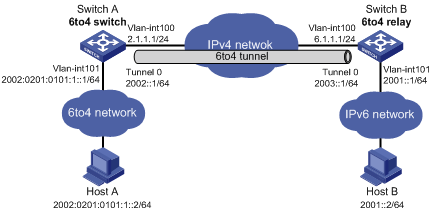
Configuration procedure
Make sure Switch A and Switch B have the corresponding VLAN interfaces created and can reach each other through IPv4.
· Configure Switch A:
# Specify an IPv4 address for VLAN-interface 100.
<SwitchA> system-view
[SwitchA] interface vlan-interface 100
[SwitchA-Vlan-interface100] ip address 2.1.1.1 255.255.255.0
[SwitchA-Vlan-interface100] quit
# Specify a 6to4 address for VLAN-interface 101.
[SwitchA] interface vlan-interface 101
[SwitchA-Vlan-interface101] ipv6 address 2002:0201:0101:1::1/64
[SwitchA-Vlan-interface101] quit
# Create the 6to4 tunnel interface Tunnel 0.
[SwitchA] interface tunnel 0 mode ipv6-ipv4 6to4
# Specify an IPv6 address for the tunnel interface.
[SwitchA-Tunnel0] ipv6 address 2002::1/64
# Specify the source interface as VLAN-interface 100 for the tunnel interface.
[SwitchA-Tunnel0] source vlan-interface 100
[SwitchA-Tunnel0] quit
# Configure a static route destined for the 6to4 relay switch.
[SwitchA] ipv6 route-static 2002:0601:0101:: 64 tunnel 0
# Configure a default route to reach the IPv6 network, which specifies the 6to4 address of the 6to4 relay switch as the next hop.
[SwitchA] ipv6 route-static :: 0 2002:0601:0101::1
· Configure Switch B:
# Specify an IPv4 address for VLAN-interface 100.
<SwitchB> system-view
[SwitchB] interface vlan-interface 100
[SwitchB-Vlan-interface100] ip address 6.1.1.1 255.255.255.0
[SwitchB-Vlan-interface100] quit
# Specify an IPv6 address for VLAN-interface 101.
[SwitchB] interface vlan-interface 101
[SwitchB-Vlan-interface101] ipv6 address 2001::1/16
[SwitchB-Vlan-interface101] quit
# Create the 6to4 tunnel interface Tunnel 0.
[SwitchB] interface tunnel 0 mode ipv6-ipv4 6to4
# Specify an IPv6 address for the tunnel interface.
[SwitchB-Tunnel0] ipv6 address 2003::1/64
# Specify VLAN-interface 100 as the source interface of the tunnel interface.
[SwitchB-Tunnel0] source vlan-interface 100
[SwitchB-Tunnel0] quit
# Configure a static route destined for 2002::/16 through the tunnel interface.
[SwitchB] ipv6 route-static 2002:: 16 tunnel 0
Verifying the configuration
# Verify that Host A and Host B can ping each other.
D:\>ping6 -s 2002:201:101:1::2 2001::2
Pinging 2001::2
from 2002:201:101:1::2 with 32 bytes of data:
Reply from 2001::2: bytes=32 time=13ms
Reply from 2001::2: bytes=32 time=1ms
Reply from 2001::2: bytes=32 time=1ms
Reply from 2001::2: bytes=32 time<1ms
Ping statistics for 2001::2:
Packets: Sent = 4, Received = 4, Lost = 0 (0% loss),
Approximate round trip times in milli-seconds:
Minimum = 0ms, Maximum = 13ms, Average = 3ms
Configuring an ISATAP tunnel
Follow these guidelines when you configure an ISATAP tunnel:
· You do not need to configure a destination address for an ISATAP tunnel, because the destination IPv4 address is embedded in the ISATAP address.
· Because automatic tunnels do not support dynamic routing, configure a static route destined for the destination IPv6 network at each tunnel end. You can specify the local tunnel interface as the egress interface of the route or specify the IPv6 address of the peer tunnel interface as the next hop of the route. For more information about route configuration, see Layer 3—IP Routing Configuration Guide.
· The source addresses of local tunnels of the same tunnel mode cannot be the same.
To configure an ISATAP tunnel:
|
Step |
Command |
Remarks |
|
1. Enter system view. |
system-view |
N/A |
|
2. Enter ISATAP tunnel interface view. |
interface tunnel number [ mode ipv6-ipv4 isatap ] |
N/A |
|
3. Specify an IPv6 address for the tunnel interface. |
See "Configuring basic IPv6 settings." |
By default, no IPv6 address is configured for the tunnel interface. |
|
4. Configure a source address or source interface for the tunnel interface. |
source { ip-address | interface-type interface-number } |
By default, no source address or source interface is configured for the tunnel interface. The specified source address or the primary IP address of the specified source interface is used as the source IP address of tunneled packets. |
|
5. Return to system view. |
quit |
N/A |
Configuration example
By default, Ethernet, VLAN, and aggregate interfaces are shut down. You must use the undo shutdown command to bring them up. This example assumes that all these interfaces are already up.
Network requirements
As shown in Figure 13, configure an ISATAP tunnel between the switch and the ISATAP host so the ISATAP host in the IPv4 network can access the IPv6 network.

Configuration procedure
· Configure the switch:
# Specify an IPv6 address for VLAN-interface 100.
<Switch> system-view
[Switch] interface vlan-interface 100
[Switch-Vlan-interface100] ipv6 address 3001::1/64
[Switch-Vlan-interface100] quit
# Specify an IPv4 address for VLAN-interface 101.
[Switch] interface vlan-interface 101
[Switch-Vlan-interface101] ip address 1.1.1.1 255.0.0.0
[Switch-Vlan-interface101] quit
# Create the ISATAP tunnel interface Tunnel 0.
[Switch] interface tunnel 0 mode ipv6-ipv4 isatap
# Specify an EUI-64 IPv6 address for the tunnel interface.
[Switch-Tunnel0] ipv6 address 2001:: 64 eui-64
# Specify VLAN-interface 101 as the source interface of the tunnel interface.
[Switch-Tunnel0] source vlan-interface 101
# Disable RA suppression so that the ISATAP host can acquire information such as the address prefix from the RA message advertised by the ISATAP switch.
[Switch-Tunnel0] undo ipv6 nd ra halt
[Switch-Tunnel0] quit
· Configure the ISATAP host:
Configurations on the ISATAP host vary by operating system. The following example is performed on Windows XP.
# Install IPv6.
C:\>ipv6 install
# On a host running Windows XP, the ISATAP interface is typically interface 2. Display information about the ISATAP interface.
C:\>ipv6 if 2
Interface 2: Automatic Tunneling Pseudo-Interface
Guid {48FCE3FC-EC30-E50E-F1A7-71172AEEE3AE}
does not use Neighbor Discovery
does not use Router Discovery
routing preference 1
EUI-64 embedded IPv4 address: 0.0.0.0
router link-layer address: 0.0.0.0
preferred link-local fe80::5efe:1.1.1.2, life infinite
link MTU 1280 (true link MTU 65515)
current hop limit 128
reachable time 42500ms (base 30000ms)
retransmission interval 1000ms
DAD transmits 0
default site prefix length 48
# Specify an IPv4 address for the ISATAP switch.
C:\>netsh interface ipv6 isatap set router 1.1.1.1
# Display information about the ISATAP interface.
C:\>ipv6 if 2
Interface 2: Automatic Tunneling Pseudo-Interface
Guid {48FCE3FC-EC30-E50E-F1A7-71172AEEE3AE}
does not use Neighbor Discovery
uses Router Discovery
routing preference 1
EUI-64 embedded IPv4 address: 1.1.1.2
router link-layer address: 1.1.1.1
preferred global 2001::5efe:1.1.1.2, life 29d23h59m46s/6d23h59m46s (public)
preferred link-local fe80::5efe:1.1.1.2, life infinite
link MTU 1500 (true link MTU 65515)
current hop limit 255
reachable time 42500ms (base 30000ms)
retransmission interval 1000ms
DAD transmits 0
default site prefix length 48
The host has acquired the address prefix 2001::/64 and has automatically generated the global unicast address 2001::5efe:1.1.1.2. The message "uses Router Discovery" indicates that the router discovery function is enabled on the host.
# Display information about IPv6 routes on the host.
C:\>ipv6 rt
2001::/64 -> 2 pref 1if+8=9 life 29d23h59m43s (autoconf)
::/0 -> 2/fe80::5efe:1.1.1.1 pref 1if+256=257 life 29m43s (autoconf)
· On the IPv6 host, configure a route to the ISATAP switch.
C:\>netsh interface ipv6 set route 2001::/64 5 3001::1
Verifying the configuration
# Verify that the ISATAP host can ping the IPv6 host.
C:\>ping 3001::2
Pinging 3001::2 with 32 bytes of data:
Reply from 3001::2: time=1ms
Reply from 3001::2: time=1ms
Reply from 3001::2: time=1ms
Reply from 3001::2: time=1ms
Ping statistics for 3001::2:
Packets: Sent = 4, Received = 4, Lost = 0 (0% loss),
Approximate round trip times in milli-seconds:
Minimum = 1ms, Maximum = 1ms, Average = 1ms
Displaying and maintaining tunneling configuration
Execute display commands in any view and reset commands in user view.
|
Task |
Command |
|
Display information about tunnel interfaces. |
display interface [ tunnel ] [ brief [ down ] ] display interface [ tunnel [ number ] ] [ brief [ description ] ] |
|
Display IPv6 information on tunnel interfaces. |
display ipv6 interface [ tunnel [ number ] ] [ brief ] |
|
Clear statistics on tunnel interfaces. |
reset counters interface [ tunnel [ number ] ] |
Troubleshooting tunneling configuration
Symptom
A tunnel interface configured with related parameters such as tunnel source address, tunnel destination address, and tunnel mode cannot come up.
Analysis
The physical interface of the tunnel does not come up, or the tunnel destination is unreachable.
Solution
1. To resolve the problem:
¡ Use the display interface or display ipv6 interface command to verify that the physical interface of the tunnel is up. If the physical interface is down, check the network connection.
¡ Use the display ipv6 routing-table or display ip routing-table command to verify that the tunnel destination is reachable. If the route is not available, configure a route to reach the tunnel destination.
2. If the problem persists, contact H3C Support.

